Identify and Manage Biodiversity-related Financial Risks: The French Practice
background
Biodiversity is the basis for human survival and development, and provides essential ecological support and ecosystem services for human beings. Economic activities and financial assets dependent and have impacts on biodiversity and ecosystem services, and biodiversity loss may also produce significant threat to economic and financial stability. In December 2022, the second phase of the 15th meeting of the Conference of the Parties (COP15) to the UN Convention on Biological Diversity (CBD), under China’s presidency, successfully agreed on the historic Kunming-Montreal Global Biodiversity Framework, which sets a new benchmark for the shared vision of living in harmony with nature by 2050. The framework puts forward that by 2030 at least 30 percent of areas of degraded terrestrial, inland water, and coastal and marine ecosystems are under effective restoration, and also puts forward more specific action targets for financial institutions and other business sectors, including monitoring, assessing and disclosing biodiversity-related risks, which inject stronger impetus into further promoting financial support for biodiversity conservation.
The negative impact of economic activities on biodiversity and the systemic financial risks caused by biodiversity loss have attracted the attention of global central banks, regulators and financial institutions. In March 2022, a joint study by the Network of Central Banks and Supervisors for Greening the Financial System (NGFS) and the International Network for Sustainable Financial Policy Insights, Research and Exchange (INSPIRE) revealed that biodiversity loss may pose significant risks to economic and financial stability, and suggested that central banks and financial regulators need to assess the exposure and financial risks of financial system to biodiversity loss, which should include assessing the dependency and impact of financial activities on biodiversity, conducting scenario analysis and stress testing of biodiversity-related financial risks, and developing a system of indicators to measure biodiversity-related financial risks. In recent years, ongoing researches in this area are being conducted by the central banks of Netherlands, France, Brazil, Malaysia and China.
Since 2022, Taskforce on Biodiversity Finance of The Green Finance Committee of China Society for Finance and Banking (GFC) (hereinafter referred to as the “Taskforce”) has been focusing on how finance supports biodiversity conservation and how financial institutions can prevent biodiversity-related financial risks, and promotes the members of GFC to carry out cutting-edge research and innovative practices in biodiversity finance. At present, the Taskforce has launched nine initial research reports. Meanwhile, the Taskforceactively organizes and participates in international exchanges and cooperation. For instance, cooperated with the Agence Française de Développement (AFD), the Taskforce promotes the exchange of international good practices and knowledge sharing between China and France in this field. Recently, with the support of the China Biodiversity Facility (CBF) and the AFD, the Chinese versions of two French research reports focusing on the identification and management of biodiversity-related financial risks have been officially published.
Brief introduction of the two research reports
Working Paper: A “Silent Spring” for the Financial System? Exploring Biodiversity-Related Financial Risks in France
Date:English Version August 2021,Chinese Version April 2023
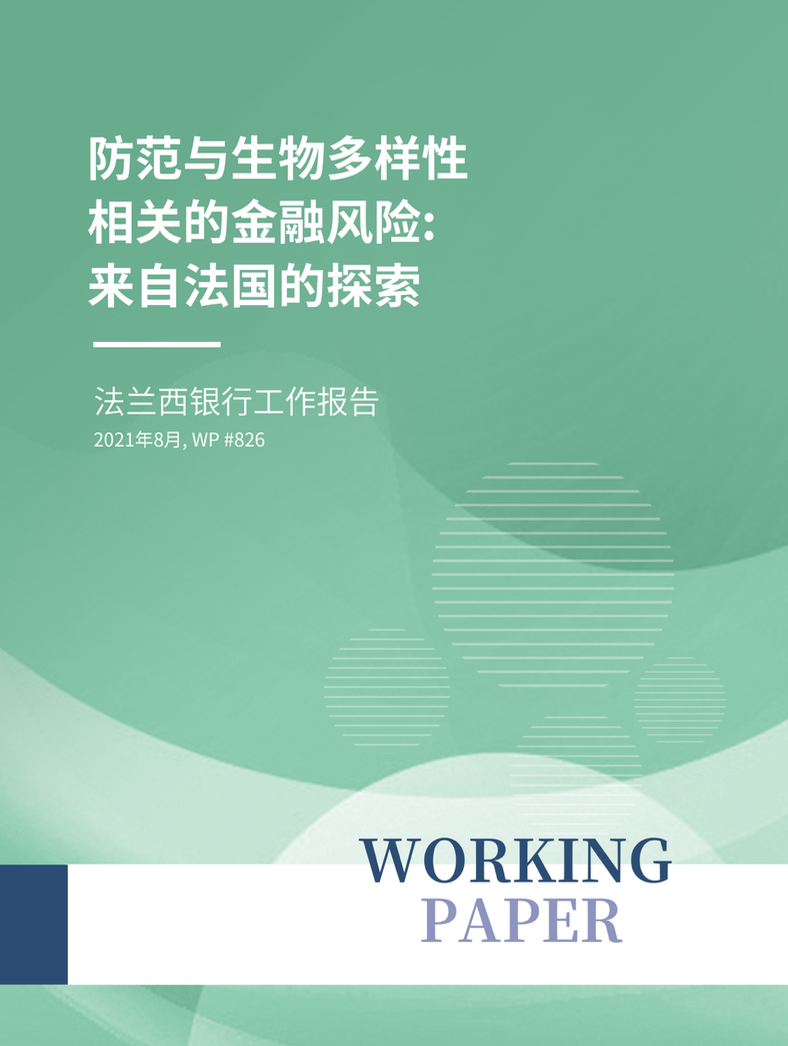
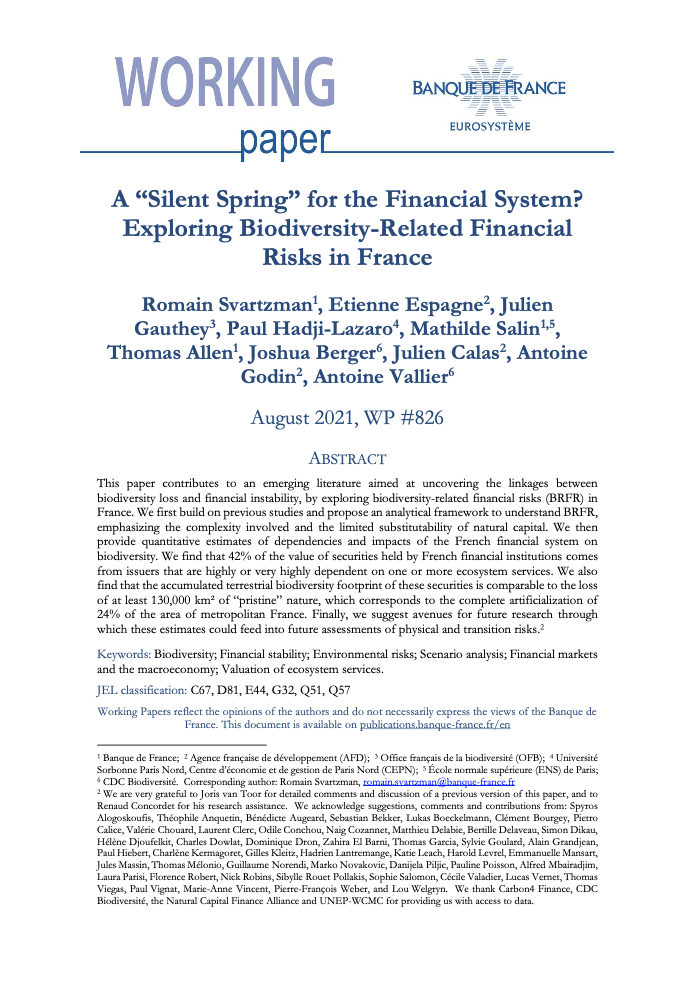
 (Chinese Version ) (English Version)
(Chinese Version ) (English Version)
The report aims to present the ongoing research on biodiversity-related financial risks in France and it is groundbreaking in its exploration of biodiversity loss and financial stability. The English version of the report was officially published by the Banque de France in August 2021.
Build on previous studies, the report proposes an analytical framework to understand biodiversity-related financial risks (BRFR), emphasizing the complexity involved and the limited substitutability of natural capital. According to the report, the French financial system faces two types of biodiversity-related financial risks, namely physical risks and transition risks. In order to assess these risks, the report provides quantitative estimates of dependencies and impacts of the French financial system on biodiversity. In terms of assessing physical risks, the report assesses the dependencies of the French financial system on biodiversity, based on the ENCORE (Exploring Opportunities, Risks and Exposures to Natural Capital) methodology. The report shows that 42% of the value of securities held by French financial institutions comes from issuers that are highly or very highly dependent on one or more ecosystem services. In terms of assessing transition risks, the report assesses the negative impacts of the French financial system on biodiversity, based on the BIA-GBS (Biodiversity Impact Analytics – Global Biodiversity Score) methodology. The report concludes that the accumulated terrestrial biodiversity footprint of these securities is comparable to the loss of at least 130,000 km² of “pristine” nature, which corresponds to the complete artificialization of 24% of the area of metropolitan France.
On this basis, the report puts forward further research suggestions on physical risk and transition risk assessment: (i) developing biodiversity-related scenario analysis tailored to financial risk assessment, with more granularity on the nature of the shocks we might face and their transmission channels to economic and financial agents; (ii) applying specific methodological approaches to capture the potential transmission of BRFR across many economic sectors and financial institutions, given the limited or non-substitutability of natural capital and/or the tail risks related to crossing tipping points; and (iii) working with ad hoc conceptual frameworks such as double materiality (already reflected in French regulations), and in particular developing new tools through which the alignment of financial institutions with biodiversity-related goals could be assessed.
Working Paper: Global biodiversity scenarios: what do they tell us for biodiversity-related socio-economic impacts?
Date: English Version December 2022, Chinese Version April 2023
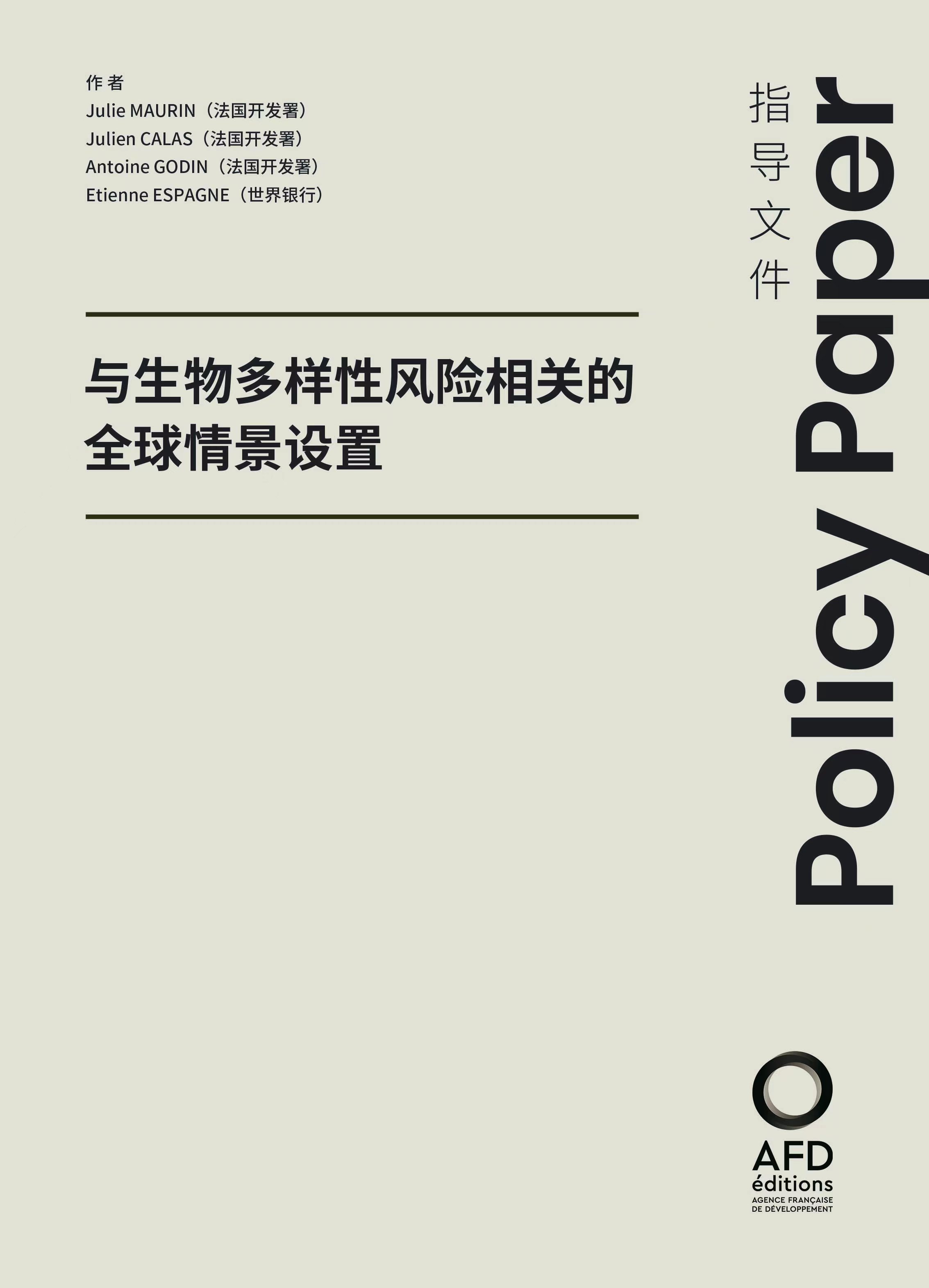
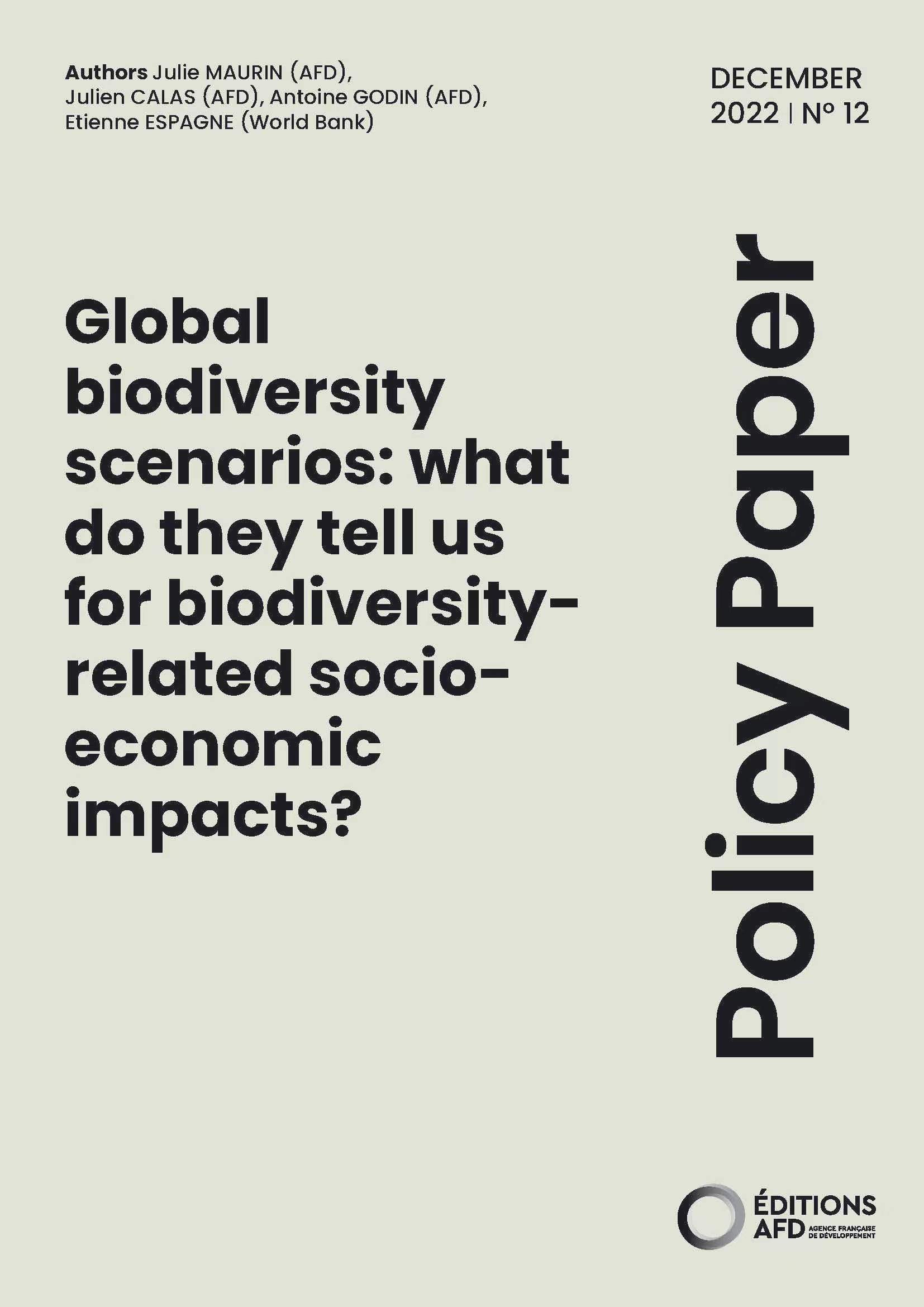
 (Chinese Version) (English Version)
(Chinese Version) (English Version)
The report aims to review and compare existing global and quantitative biodiversity scenarios that could help to build a forward-looking assessment of the consequences of biodiversity loss. The English version of the report was officially published by the AFD in December 2022.
The report provides a literature review of existing biodiversity scenarios and models as well as an assessment of the path forward for research to developing scenarios for biodiversity related socio-economic impacts at each step of the process: from building narratives, quantifying the impacts and dependencies, assessing the uncertainty range on the results all the way from the ecosystem to the economic and financial asset. The report finds that: (i) global and quantitative physical risk scenarios are almost absent; this is why we concentrate on transition scenarios of biodiversity; (ii) most ecological transition scenarios are built in accordance with the conservation goals of the Convention on Biological Diversity (CBD), even if future land allocation varies across studies; (iii) the Shared Socio-economic Pathways (SSPs) and Representative Concentration Pathways (RCPs) to assess socio-economic and climate change trajectories do not entirely incorporate the spatial implications of their economic growth hypothesis; (iv) the report underline the need to incorporate the uncertainties inherent to these integrated models, as well as the functional uncertainty of biodiversity indicators, which measure only a tiny fraction of global biodiversity. Based on this, the report summaries recommendations for shorter-term improvements in assessing socio-economic impacts.
About biodiversity-related financial Risks identification and management for financial institutions
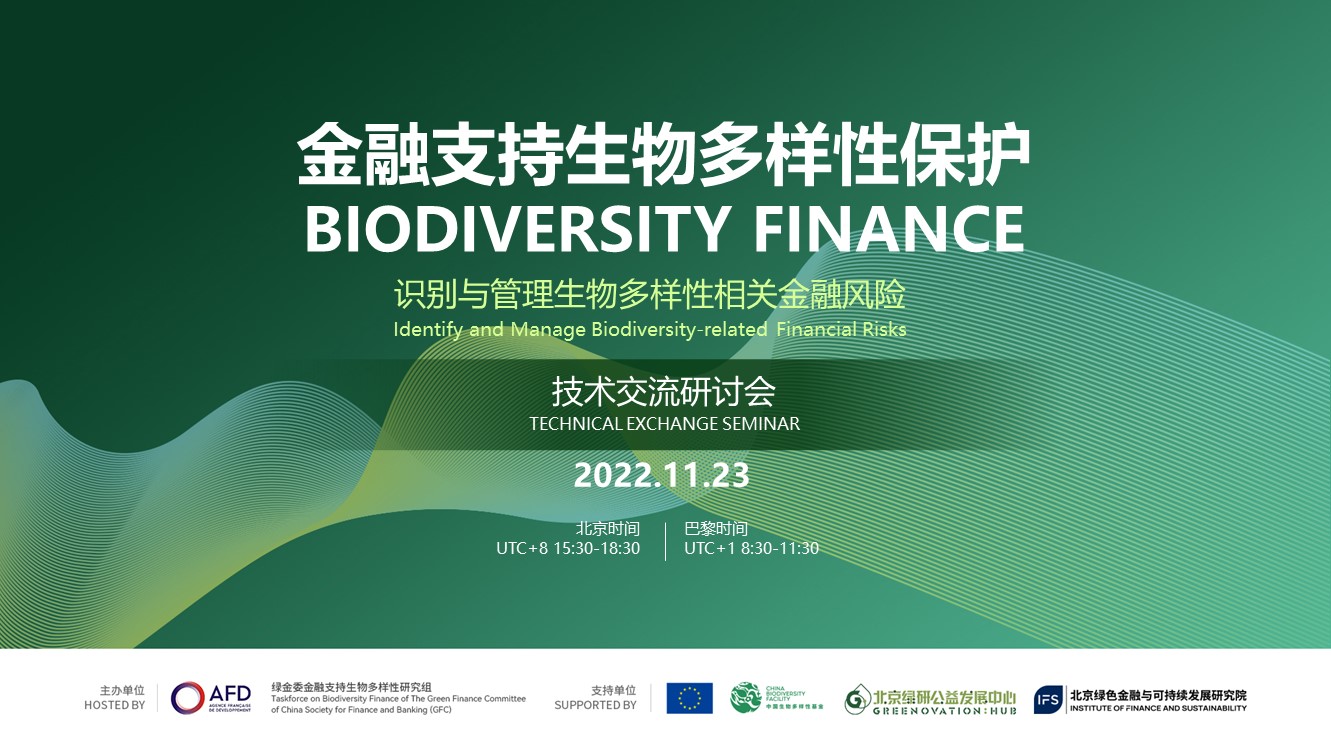 Taskforce on Biodiversity Finance of The Green Finance Committee of China Society for Finance and Banking (GFC) and AFD co-hosted a technical exchange seminar in November 2022 on biodiversity-related financial risks identification and management for financial institutions, with the support of the China Biodiversity Facility (CBF). The seminar brought together experts and practitioners from financial and research institutions such as World Bank, Taskforce on Nature-Related Financial Disclosures (TNFD), AFD and World Economic Forum to discuss cutting-edge research and practice relating to nature and biodiversity-related financial risks management issues at the global level. The seminar is the third public policy dialogue between France and China since 2021, which aims to foster dialogues and knowledge sharing regarding biodiversity finance for financial institutions, so as to enhance bilateral exchanges and cooperation, and further promote biodiversity-related risk capacity-building and good practices for Chinese financial sectors.
Taskforce on Biodiversity Finance of The Green Finance Committee of China Society for Finance and Banking (GFC) and AFD co-hosted a technical exchange seminar in November 2022 on biodiversity-related financial risks identification and management for financial institutions, with the support of the China Biodiversity Facility (CBF). The seminar brought together experts and practitioners from financial and research institutions such as World Bank, Taskforce on Nature-Related Financial Disclosures (TNFD), AFD and World Economic Forum to discuss cutting-edge research and practice relating to nature and biodiversity-related financial risks management issues at the global level. The seminar is the third public policy dialogue between France and China since 2021, which aims to foster dialogues and knowledge sharing regarding biodiversity finance for financial institutions, so as to enhance bilateral exchanges and cooperation, and further promote biodiversity-related risk capacity-building and good practices for Chinese financial sectors.
Related Achievements


